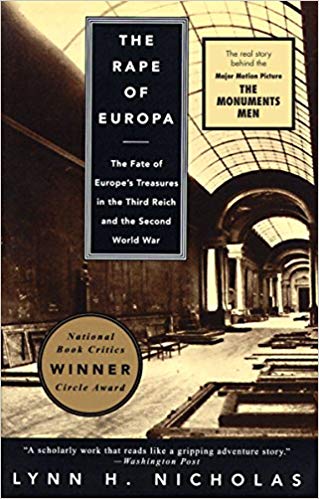Polokaust By Starvation and Cultural Genocide Nicholas

The Rape of Europa, by Lynn H. Nicholas. 1995
The German Plunder of Poland, and the Planned Extended Polokaust
Author Lynn Nicholas traces the plunder of cultural treasures Nazi Germany followed the Allies’ efforts to locate and return the booty. The Germans also engaged in the wanton destruction of others’ cultural treasures, beginning with the very start of WWII. For instance, the German forces deliberately bombed and shelled the historical section of Warsaw (the Old Town). (p. 61).
Spectacular German thefts include that of the giant Wit Stwosz (Veit Stoss) altar of Krakow (Cracow), and the Bursztyn Komnaty (Amber Room) of the city of Pushkin (near Leningrad; now St. Petersburg). The latter is yet to resurface. It may have been destroyed in the war.
GERMAN GUILT DIFFUSION INVALID: NO DUALISM BETWEEN THE CONDUCT OF NAZIS AND SO-CALLED ORDINARY GERMANS
The reader soon learns that the pillage of conquered nations was done not just Nazi hacks, but also German intellectuals, as in German-occupied Poland: “Even the most distinguished German scholars were not immune to the opportunities presented a cultural scene so open to exploitation…once the country lay at their feet many of these academics felt not the slightest qualms at transferring the collections, libraries, and even research notes of their erstwhile colleagues to their own use.” (p. 74).
THE EXTENDED POLOKAUST. GENOCIDE BY STARVATION
Nicholas touches on those German genocidal plans against the Slavs that were to be implemented after Germany’s expected victory over Russia: “The basic policies would be the same as those applied to Poland. After conquest, areas would be cleansed, exploited, and Germanized…In these [German-appointed districts] the cleansing would again be cultural, racial, and ideological. Not only Jews and ‘Bolshevists’ would be eliminated by immediate execution; much of the general Slavic population would be allowed to expire naturally when their food supplies were diverted to the worthier citizens of the Reich.” (p. 185)
ERRORS ON THIS BOOK
There are some distortions and omissions in this book. Nicholas repeats the myth of the Poles “arriving at” an already-abandoned Monte Cassino (p. 247) when in actuality the Poles had to overcome fierce German resistance, and to take grievous casualties, in order to take Monte Cassino. She elaborates on the Germans’ burning of the libraries and archives of Naples (pp. 232-233), and the agony of the Soviet-betrayed Warsaw Uprising (p. 77), but not the magnitudes-greater destruction of Warsaw’s cultural treasures. AFTER the fall of the Warsaw Uprising, the vindictive Germans burnt and blew up the still-standing architectural treasures of Warsaw. They also burned all the libraries and archives of Warsaw, causing the loss of 13 million volumes, including about 500,000 irreplaceable ones.
To see a series of truncated reviews in a Category click on that Category:
- All reviews
- Anti-Christian Tendencies
- Anti-Polish Trends
- Censorship on Poles and Jews
- Communization of Poland
- Cultural Marxism
- German Guilt Dilution
- Holocaust Industry
- Interwar Polish-Jewish Relations
- Jewish Collaboration
- Jewish Economic Dominance
- Jews Antagonize Poland
- Jews Not Faultless
- Jews' Holocaust Dominates
- Jews' Holocaust Non-Special
- Nazi Crimes and Communist Crimes Were Equal
- Opinion-Forming Anti-Polonism
- Pogrom Mongering
- Poland in World War II
- Polish Jew-Rescue Ingratitude
- Polish Nationalism
- Polish Non-Complicity
- Polish-Ukrainian Relations
- Polokaust
- Premodern Poland
- Recent Polish-Jewish Relations
- The Decadent West
- The Jew as Other
- Understanding Nazi Germany
- Why Jews a "Problem"
- Zydokomuna